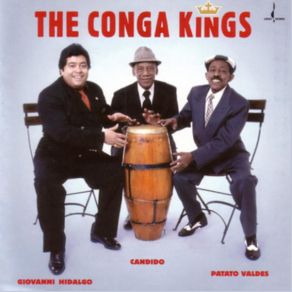The Conga Kings
Download links and information about The Conga Kings by Candido, Giovanni Hidalgo, Patato Valdes. This album was released in 2000 and it belongs to Salsa, Latin genres. It contains 3 tracks with total duration of 11:24 minutes.

|
|
|---|---|
| Artist: | Candido, Giovanni Hidalgo, Patato Valdes |
| Release date: | 2000 |
| Genre: | Salsa, Latin |
| Tracks: | 3 |
| Duration: | 11:24 |
| Buy it NOW at: | |
| Buy on iTunes Partial Album | |
| Buy on Amazon $8.99 | |
Tracks
[Edit]| No. | Title | Length |
|---|---|---|
| 1. | Tumbando Caña | 8:00 |
| 2. | Elube Chango | 0:27 |
| 3. | Guagancó Pa' las Tumbadoras | 2:57 |
Details
[Edit]Between Candido, Giovanni Hidalgo and Carlos "Patato" Valdes, the entire history of Afro-Cuban music is represented, and as conga players they are peerless. The sound of this recording is most intriguing, done at St. Peter's Episcopal Church/NYC with one microphone. Though the sound is thin of presence it is fully balanced and rich: feel free to turn it up and kick in the sub-woofer. Bassist Guillermo Edgehill, tres players Nelson Gonzalez and John Benthal, the great flute player Mauricio Smith, percussionists Jose Francisco Valdes (claves) and Joe Gonzalez (bongos) and three singers are in the mix, but they never get in the way of the kings. Where the conga men are front and center throughout, it is the brilliant veteran Smith who shines just as bright. His spare flute floats over the coro and clave rhythm with ostinato tres on the endless jam "Tumbando Cana," easy tres montuno with Smith's ultra-melodicism is effortless during "Guaguanco Pa' las Tumbadoras," while the sung son "Nague" repeats the title incessantly while Smith's solo is as piquant and poignant as it gets. Overblown harmonics and fluttering flute informs the "Duet II" with Patato. Edgehill is also quite good, leading the percussionists with ostinato on the "Descarga de Los Reyes," and engaging in call and response with Candido during "Duet III." "Tuna Se Quemo" is the most out and out, montuno braised descarga, with a wonderful tres solo from Gonzalez. The cuts featuring vocals include the delicate yet deliberate repeated line of "Elube Chango," and the tres buoyed, lighter "Duet I; Temporal" (not really a duet) with insistent conga. Each percussionist gets solo space on two cuts; "Avisale a Mi Contrario" also uses a repeated vocal line with clave rhythm, bass and individual spotlights, while the "Grand Finale" has each player soloing, quite melodic in his own way, then together in a six/eight slow burn. Considering there are as many as ten conga drums going at once, the sonic reproduction is remarkably distinct. The music is firmly rooted in tradition, exciting from start to finish, and a perfect vehicle for students to learn the authentic rhythms which these three masters have led their lives by. ~ Michael G. Nastos, Rovi